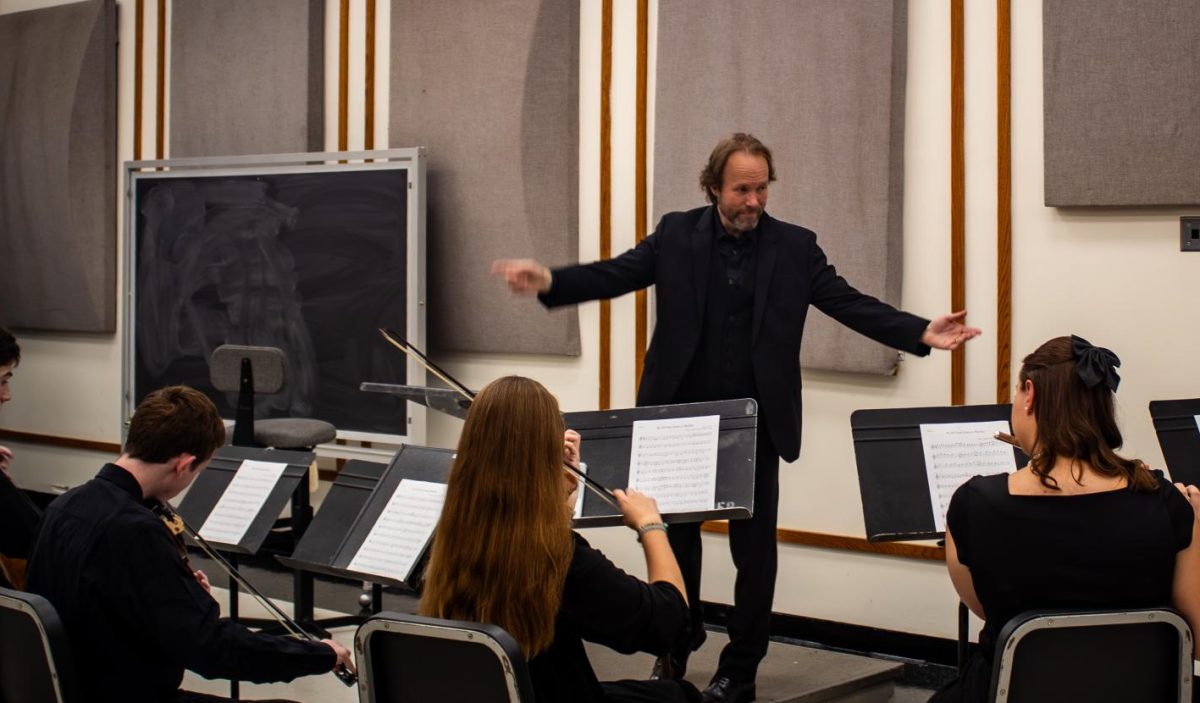Training for Spring Sports Battles Winter Conditions
Men’s lacrosse player Justin Headley practices against head coach Scott Gwyn and Graduate Assistant Jacob Karmia in an early season practice
April 6, 2023
Chicago weather in late January and early February is often anything but pleasant, with sub-freezing temperatures, snow and ice, and frequently high winds.
Yet the men’s lacrosse, women’s lacrosse, softball, and baseball teams all hold their first practice in late January, when the weather often makes spending time outside miserable.
One of the little-known tasks these coaches face is figuring out how to ensure practice time is productive when temps drop and the fields are snowy or icy. This can be anything from limiting time outside, moving practice times, or forcing outdoor teams inside.
“The biggest issue posed by early season practices is either ice or the temperature,” says men’s lacrosse head coach Scott Gwyn. “Depending on the temperature during snowfall, we may have to worry about ground melt creating ice patches. Ice is more of a determining factor of ‘we cannot go outside’ than snow is.”
While snow and even ice can be dealt with thanks to shoveling and snow plows, cold temperatures are “something you cannot control or mitigate,” says Gwyn. Once the temperature drops below 20 degrees Fahrenheit, Gwyn’s players must follow a warming policy, where they are allowed to be outside for a certain amount of time based on the temperature before a warming period must be taken inside. This warming policy is set by the Northern Athletics Collegiate Conference, the governing athletic conference for CUC.
Care of the turf field falls under Gwyn’s jurisdiction. “I’m not sure I have an official title for my duties on the field; I would say field caretaker is probably closest,” says Gwyn. One of Gwyn’s responsibilities is plowing snow on the field with a snow plow-equipped tractor from CUC’s physical plant.
Gwyn also has more creative solutions to handling snow on the field. One of his tricks is placing trash cans upside down around the field. After snowfalls, taking off the trash cans leave behind “bald-spots” of grass, which heat up faster once the sun emerges. As a result, the field is as much as 10 degrees warmer than ambient air temperature, helping the snow melt faster.
Meanwhile, softball coach Sarah O’Malley-Fisher is concerned about the state of the CUC Softball Field. “Field conditions are a part of why we cannot get outside,” O’Malley-Fisher explains. “The field has to be dry and must thaw out before we can get on it.”
On average, Chicago receives 1.9 inches of precipitation during February, according to the National Weather Service. That number jumps up to 2.5 inches in March. In April, which features the bulk of games for spring sports, over 3.7 inches of precipitation can be expected.
To avoid the muddy field, softball practices are frequently held in the MAXX Dome in McCook and the Bo Jackson Elite Sports Dome in Bensenville. “The department has done a really great job in supporting our practices off-site,” says O’Malley-Fisher. “These indoor facilities give us an opportunity to have full team practices and scrimmages and are great for getting ready for the spring.”
The CUC Softball Field is kept tarped during the winter months to help the field dry out more quickly in the spring. The sooner the field is dry, the earlier players can practice on it.
Softball usually starts practicing outside regularly in mid-March when the team returns from their annual Spring Break trip to Florida.
Baseball coach Kolin Conner and the baseball team also take care of Cougar Field, the baseball field, while using indoor facilities in January, February, and most of March. The team typically moves practice to the baseball field in late March.
“We fundraise every year and some of that is used to offset facility rental,” says Conner. When needed, Conner and his team will take the 22 minute drive to the Bo Dome, and while Conner says “it’s never ideal to be inside,” the team “can get a lot done over there due to how great the space is.”
Conner says Cougar Field “drains and handles the weather really well.” The team will also practice on the turf football field at Cougar Stadium when they want to be outside but Cougar Field is not in playable condition.
The coaches come equipped with backup plans as well, for days where practice is supposed to be outside but weather throws a wrench in the plans.
O’Malley-Fisher says the MAXX and Bo Dome often provide help if softball needs a last minute place to practice. The team is also creative about using available space at the school, using the gym or the batting cages behind the bleachers to work on different aspects of the game like fielding, batting, and pitching.
Conner has a similar backup plan for his baseball players, using either gym space at CUC or the Bo Dome when weather presents an issue. “We do everything we can to make sure they get the best out of every situation and we will find a way to get better anywhere,” Connor says.
For both the men’s and women’s lacrosse teams, an hour or so is reserved everyday within CUC’s indoor facilities from Jan. 1 until March 31 in case a move inside is necessary, explains Gwyn. However, due to the need of indoor space by other teams, Gwyn tries to make a decision if his team will be inside a day or two beforehand.


































